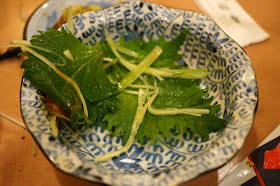As I always say, you have to sit at the counter whenever you eat sushi.
Cucumber wrapped in Oshinko.
Start off with some draft beer. One thing I noticed in Japan is that most dinner gatherings begin with "nama" (draft beer), then onto either sake or shochu.
Negitoro Otsumami
This is Sushi Go's signature menu - negitoro served as a snack or in Korean term "안주" (anju). Otsumami refers to food eaten as an accompaniment to alcohol. Negitoro is typically served as a maki, negiri, or hand roll. Those are all available here as well but most customers choose the otsumami option.
Negitoro served maki style (@Sushi Daiwa, Tsukiji Market)
Negitoro served nigiri style (also @Sushi Daiwa, Tsukiji Market)
*I'll do a post on Sushi Daiwa soon
Back to Sushi Go. If I remember correctly, this handful of negitoro is about $18. I hate eating negitoro in Korea because it always has that metallic flavor, meaning the quality of tuna is extremely low. Nothing but high grade chutoro (medium fatty tuna) at Sushi Go.
Ok, so how do you eat that thing, you ask?
Wrapped inside fresh nori with a pinch of wasabi, then dipped in soy sauce.
Another variation with some fresh seaweed.
Uni served otsumami style. Ugh, so beautiful.
I don't recall how much this was. I didn't care. Just give it to me!
Eating uni and negitoro otsumami style highlights two things:
1. You can focus on the actual flavor of the ingredient without the rice. Not to say that rice is bad because highly rated sushi chefs take decades to perfect the rice and its flavor. I guess you can say it's the same as eating uni sashimi style.
2. You don't get full from all the rice. Sushi is regarded as one of the healthiest foods out there but in reality, it's a lot of carbs from all that rice.
Christine practically ate the entire first bowl. One more order!
Man.. I miss this.
Torigai (Japanese Cockle, more commonly referred to as Bird Clam in Japan)
Shochu on the rocks.
Time for some sushi now. Amaebi.
The heads of the amaebi are served fried. I always have to ask for this in Korea and get a funny look from the waiters but no need to ask in Japan - it's expected.
I did get a funny look from the sushi chef when I asked for some mayo. Anything fried deserves a side of mayo!
Tamago
Anago (Salt-water Eel)
We prefer Unagi (Fresh-water Eel) but they didn't have any available.
Otoro. Saved the best for last.
I asked for a big piece and he certainly served up a big one. Despite the lack of marbling on the fish, this literally melted in my mouth.
Baked Iidako (Baby Octopus) on the house.
More mayonnaise!
So couple things usually happen when you sit at the counter of any restaurant. You get to chat with the chef and talk about what's fresh and recommeded for that day. Another is chatting up with the people next to you. So Christine and I were speaking Korean throughout the meal and these two gentlemen sitting next to us happened to be third generation Korean-Japanese and started talking to us. Their Japanese was much better than their Korean and it was very interesting to meet a Korean-Japanese as we spoke about Korea-Japan relations and how they felt about that as a Korean-Japanese. Thanks for the ocha-wari (green tea shochu) rounds as well as this piece of Chutoro sushi!
Nice little surprise when we got back to our hotel room. It was actually my last day of work in Japan and one of the managers sent a congratulatory cake up to our room.
There's a lot of concern and controversy about Japanese fish after the
Fukushima radiation incident and I definitely am more concerned about
eating fish in Japan. However, from my observation, Japanese people
seem to have zero concern eating fish, even sushi and sashimi. We tried
to limit our fish consumption during our trip but couldn't eliminate it
completely because of places like Sushi Go. I would hope that the
government of Japan is doing the right things to block contaminated fish from entering the market.
오카치마치 스시고 (Okachimachi Sushi Go)
東京都
台東区
上野
4-2-11
3 minute walk from JR Okachimachi Station North Exit
03-3831-9648


































댓글 없음:
댓글 쓰기